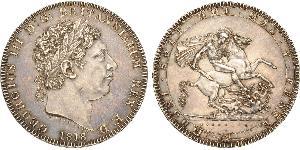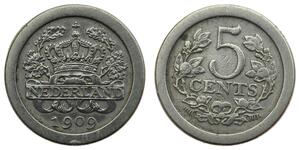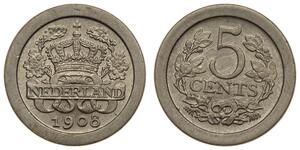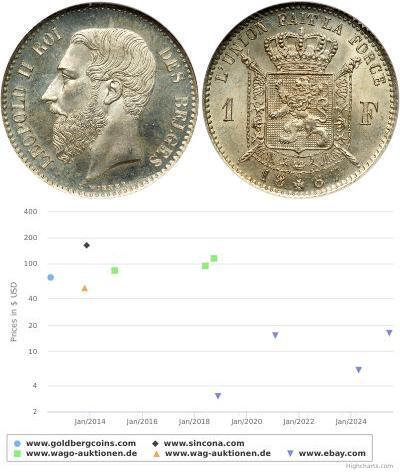1 Sovereign United Kingdom of Great Britain and Ireland (1801-192 ...
Metal:
Issue year(s):
1821
Person:
Great Britain. Sovereign, 1821. S-3800; WR-231; Fr-376; KM-682. George IV, 1820-1830. Plump, Laureate Head left. Reverse: St George and the Dragon, date below.
type to read more
Some 21 million sovereigns of the Laureate Head style were coined between 1821 and 1825, of which only during 1823 did the mintage fall below one million (616,770 struck in 1823). And then this regal style ended, being replaced at the king’s own command by the Bare Head portrait issue. It is a familiar story that during 1823 the new portrait was first prepared as a medallion by Sir Francis Chantrey. The obverse die for the sovereign was engraved by J.B. Merlen, as Pistrucci famously refused to simply copy the work of another artist. The king approved of it without delay, and in mid-year 1825 the new portrait began to appear. George IV was a vain man who had admired a large bust of himself in this style, showing him to be slimmer in demeanour than the Laureate portrait suggested; but he was not slim at all, and in fact the first style of portrait, as seen on this sovereign, is the more lifelike. Despite the obviously lower output of sovereigns in 1823, however, there is no specific reason for this date’s rarity. Economic activity in 1823 was not out of the ordinary. In fact there is the suggestion in all histories of economic plenty at the time, which doubtless accounts for the issue of the Two Pound gold coin struck only during 1823 for commerce. Half sovereigns of 1823 were also struck in smaller numbers compared to other years in this series. It must be that the Two Pound coin was seen, at the time, as reducing the requirement for gold sovereigns used in commercial transactions, although clearly the larger coin was deemed unnecessary in subsequent years, as no others were made for commercial purposes until the Jubilee issue of 1887. The gold sovereign continued to be the standard for trade purposes, both at home and across the empire.
73
coins in the group
View all coins in the group
View all coins in the group
(2081 X 1050 pixels, file size: ~400K)
Posted by: anonymous 2024-04-09
1822 Britain George IV Gold Sovereign Coin 1S - Certified NGC AU Details
(1200 X 594 pixels, file size: ~216K)
Posted by: anonymous 2016-12-05
GROSSBRITANNIEN George IV. 1820-1830. Sovereign 1821. 7.95 g. S. 3800. Schl. 118. Fr. 376. Gutes sehr schön.
(900 X 442 pixels, file size: ~97K)
Posted by: anonymous 2015-08-26
G British Coins. A Selection of Sovereigns. George IV , sovereign, 1825, laur. head l., rev. St. George and the dragon (S.3800), in plastic holder, graded by NGC as MS62, practically mint state, very rare in this grade £5000-6000
(900 X 439 pixels, file size: ~100K)
Posted by: anonymous 2015-08-26
G British Coins. A Selection of Sovereigns. George IV , sovereign, 1822, laur. head l., rev. St. George and the dragon (S.3800), small scratch under bust and in front of face, very fine £300-350
(900 X 443 pixels, file size: ~68K)
Posted by: anonymous 2015-08-26
G British Coins. A Selection of Sovereigns. George IV , sovereign, 1821, laur. head l., rev. St. George and the dragon (S.3800), in plastic holder, graded by NGC as MS64, nearly as struck and sharply impressed with high rims, satiny mint frost, and small abrasions only, a particularly fine exam ...
(520 X 260 pixels, file size: ~50K)
Posted by: anonymous 2015-08-25
G George IV, sovereign, 1825, laur. head l., rev. St. George and the dragon (S.3800), edge bruise at 7 o'clock on reverse, very fine, very rare
You may be interested in following coins
2025-05-25
- New coin is added to 5 Cent Netherlands
5 Cent Netherlands
group has 11 coins / 8 prices
⇑
Netherlands - 5 Cents 1908 - Wilhelmina
2025-05-27
- Historical Coin Prices
You may be interested in ...

-500-250-c27BwcI0Tz4AAAEp0JgFQRcX.jpg)
-300-150-MSmsHgTyEh8AAAGOq6GdpsBW.jpg)
-300-150-1EEKX9ISEvcAAAFYcUm668yn.jpg)
-300-150-VnYKbzbiBpcAAAFP9iltcWr7.jpg)
-300-150-KDcKbzbigewAAAFP3p5tcWr6.jpg)
-300-150-NP0KbzbiQjIAAAFPNCJtcWr6.jpg)
-300-150-jFQKbzbiBzMAAAFPoIptcWXZ.jpg)














